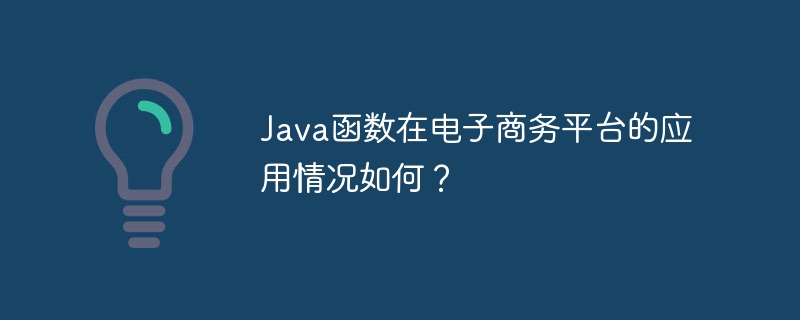How are Java functions used in e-commerce platforms?
Java functions are widely used in e-commerce and play a vital role, specifically as follows: Dynamic pricing engine: calculate dynamic pricing based on real-time data, optimize profits and provide competitive pricing. Recommendation engine: Personalize product recommendations based on user data to improve customer satisfaction and conversion rates. Order Processing: Automate order processes to increase efficiency and reduce errors. Fraud detection: Analyze transaction patterns, identify potential fraudulent activities, protect customers and reduce losses.

Application of Java functions in e-commerce platforms
Java functions are widely used in today’s e-commerce platforms and play a vital role important role. The following are some practical cases showing the practical application scenarios of Java functions:
1. Dynamic pricing engine
- Use Java functions to base on real-time data (such as inventory level, market demand) to calculate dynamic pricing.
- This helps e-commerce platforms optimize profits and provide competitive pricing.
Sample code:
import java.math.BigDecimal;
public class DynamicPricingFunction {
public BigDecimal calculatePrice(Product product) {
// Get real-time data from the database
int inventoryLevel = getProductInventoryLevel(product.getId());
double marketDemand = getMarketDemandForProduct(product.getName());
// Calculate the dynamic price
BigDecimal basePrice = product.getBasePrice();
BigDecimal inventoryAdjustment = getInventoryAdjustment(inventoryLevel);
BigDecimal demandAdjustment = getDemandAdjustment(marketDemand);
BigDecimal dynamicPrice = basePrice.multiply(inventoryAdjustment).multiply(demandAdjustment);
return dynamicPrice;
}
}2. Recommendation engine
- Use Java functions based on the user’s Purchase history, preferences and other information to personalize product recommendations.
- This helps improve customer satisfaction and conversion rates.
Sample code:
import java.util.List;
public class RecommendationFunction {
public List<Product> getRecommendations(User user) {
// Get user's data from the database
List<Product> purchasedProducts = getPurchasedProducts(user.getId());
int favoriteCategory = user.getFavoriteCategory();
// Use machine learning or collaborative filtering techniques to generate recommendations
List<Product> recommendations = getRecommendations(purchasedProducts, favoriteCategory);
return recommendations;
}
}3. Order processing
- Use Java functions to automate order processing Tasks such as inventory updates, payment processing, and shipping notifications.
- This improves efficiency and reduces manual errors.
Sample code:
import java.util.Date;
public class OrderProcessingFunction {
public void processOrder(Order order) {
// Update inventory levels
updateInventoryLevels(order.getProducts());
// Process payment
processPayment(order.getTotalPrice());
// Send shipment notification
sendShipmentNotification(order.getShippingAddress(), order.getEstimatedDeliveryDate());
}
}4. Fraud detection
- Use Java functions to analyze transaction patterns and identify potential fraudulent activity.
- This helps e-commerce platforms protect customers and reduce losses.
Sample code:
import java.util.Map;
public class FraudDetectionFunction {
public boolean isFraudulent(Transaction transaction) {
// Get transaction attributes
Map<String, Object> attributes = transaction.getAttributes();
// Use machine learning or rule-based techniques to analyze the attributes and detect fraud
boolean isFraudulent = detectFraud(attributes);
return isFraudulent;
}
}Conclusion
Java functions are widely used in e-commerce platforms. From optimized pricing to personalized recommendations to automated order processing. By leveraging these functions, e-commerce businesses can improve operational efficiency, enhance customer experience, and maximize profits.
The above is the detailed content of How are Java functions used in e-commerce platforms?. For more information, please follow other related articles on the PHP Chinese website!

Hot AI Tools

Undresser.AI Undress
AI-powered app for creating realistic nude photos

AI Clothes Remover
Online AI tool for removing clothes from photos.

Undress AI Tool
Undress images for free

Clothoff.io
AI clothes remover

AI Hentai Generator
Generate AI Hentai for free.

Hot Article

Hot Tools

Notepad++7.3.1
Easy-to-use and free code editor

SublimeText3 Chinese version
Chinese version, very easy to use

Zend Studio 13.0.1
Powerful PHP integrated development environment

Dreamweaver CS6
Visual web development tools

SublimeText3 Mac version
God-level code editing software (SublimeText3)

Hot Topics
 1376
1376
 52
52
 Square Root in Java
Aug 30, 2024 pm 04:26 PM
Square Root in Java
Aug 30, 2024 pm 04:26 PM
Guide to Square Root in Java. Here we discuss how Square Root works in Java with example and its code implementation respectively.
 Perfect Number in Java
Aug 30, 2024 pm 04:28 PM
Perfect Number in Java
Aug 30, 2024 pm 04:28 PM
Guide to Perfect Number in Java. Here we discuss the Definition, How to check Perfect number in Java?, examples with code implementation.
 Random Number Generator in Java
Aug 30, 2024 pm 04:27 PM
Random Number Generator in Java
Aug 30, 2024 pm 04:27 PM
Guide to Random Number Generator in Java. Here we discuss Functions in Java with examples and two different Generators with ther examples.
 Weka in Java
Aug 30, 2024 pm 04:28 PM
Weka in Java
Aug 30, 2024 pm 04:28 PM
Guide to Weka in Java. Here we discuss the Introduction, how to use weka java, the type of platform, and advantages with examples.
 Smith Number in Java
Aug 30, 2024 pm 04:28 PM
Smith Number in Java
Aug 30, 2024 pm 04:28 PM
Guide to Smith Number in Java. Here we discuss the Definition, How to check smith number in Java? example with code implementation.
 Java Spring Interview Questions
Aug 30, 2024 pm 04:29 PM
Java Spring Interview Questions
Aug 30, 2024 pm 04:29 PM
In this article, we have kept the most asked Java Spring Interview Questions with their detailed answers. So that you can crack the interview.
 Break or return from Java 8 stream forEach?
Feb 07, 2025 pm 12:09 PM
Break or return from Java 8 stream forEach?
Feb 07, 2025 pm 12:09 PM
Java 8 introduces the Stream API, providing a powerful and expressive way to process data collections. However, a common question when using Stream is: How to break or return from a forEach operation? Traditional loops allow for early interruption or return, but Stream's forEach method does not directly support this method. This article will explain the reasons and explore alternative methods for implementing premature termination in Stream processing systems. Further reading: Java Stream API improvements Understand Stream forEach The forEach method is a terminal operation that performs one operation on each element in the Stream. Its design intention is
 TimeStamp to Date in Java
Aug 30, 2024 pm 04:28 PM
TimeStamp to Date in Java
Aug 30, 2024 pm 04:28 PM
Guide to TimeStamp to Date in Java. Here we also discuss the introduction and how to convert timestamp to date in java along with examples.




